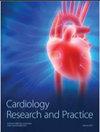Safety and Feasibility Using a Fluid-Filled Wire to Avoid Hydrostatic Errors in Physiological Intracoronary Measurements
IF 1.8
4区 医学
Q3 CARDIAC & CARDIOVASCULAR SYSTEMS
引用次数: 0
Abstract
Background. Using a fluid-filled wire with a pressure sensor outside the patient compared to a conventional pressure wire may avoid the systematic error introduced by the hydrostatic pressure within the coronary circulation. Aims. To assess the safety and effectiveness of the novel fluid-filled wire, Wirecath (Cavis Technologies, Uppsala, Sweden), as well as its ability to avoid the hydrostatic pressure error. Methods and Results. The Wirecath pressure wire was used in 45 eligible patients who underwent invasive coronary angiography and had a clinical indication for invasive coronary pressure measurement at Sahlgrenska University Hospital, Gothenburg, Sweden. In 29 patients, a simultaneous measurement was performed with a conventional coronary pressure wire (PressureWire X, Abbott Medical, Plymouth, MN, USA), and in 19 patients, the vertical height difference between the tip of the guide catheter and the wire measure point was measured in a 90-degree lateral angiographic projection. No adverse events caused by the pressure wires were reported. The mean Pd/Pa and mean FFR using the fluid-filled wire and the sensor-tipped wire differed significantly; however, after correcting for the hydrostatic effect, the sensor-tipped wire pressure correlated well with the fluid-filled wire pressure (R = 0.74 vs. R = 0.89 at rest and R = 0.89 vs. R = 0.98 at hyperemia). Conclusion. Hydrostatic errors in physiologic measurements can be avoided by using the fluid-filled Wirecath wire, which was safe to use in the present study. This trial is registered with NCT04776577 and NCT04802681.使用充液导线避免冠状动脉内生理测量中的静水误差的安全性和可行性
背景。与传统的压力导线相比,在患者体外使用带有压力传感器的充液导线可以避免冠状动脉循环内静水压带来的系统误差。目的评估新型充液导线 Wirecath(Cavis Technologies,瑞典乌普萨拉)的安全性和有效性,以及其避免静水压力误差的能力。方法和结果。瑞典哥德堡 Sahlgrenska 大学医院对 45 名符合条件的患者使用了 Wirecath 压力导线,这些患者均接受了有创冠状动脉造影术,并具有有创冠状动脉压力测量的临床指征。在 29 名患者中,使用传统冠状动脉压力线(PressureWire X,Abbott Medical,Plymouth,MN,USA)同时进行了测量;在 19 名患者中,在 90 度侧向血管造影投影中测量了导引导管尖端与压力线测量点之间的垂直高度差。没有关于压力导线导致不良事件的报告。使用充液导丝和传感器尖端导丝的平均 Pd/Pa 值和平均 FFR 值差异显著;但在校正静水效应后,传感器尖端导丝压力与充液导丝压力的相关性很好(静息时 R = 0.74 vs. R = 0.89,充血时 R = 0.89 vs. R = 0.98)。结论。使用充液 Wirecath 导丝可避免生理测量中的静水压误差,在本研究中使用该导丝是安全的。本试验已在 NCT04776577 和 NCT04802681 上注册。
本文章由计算机程序翻译,如有差异,请以英文原文为准。
求助全文
约1分钟内获得全文
求助全文
来源期刊

Cardiology Research and Practice
Medicine-Cardiology and Cardiovascular Medicine
CiteScore
4.40
自引率
0.00%
发文量
64
审稿时长
13 weeks
期刊介绍:
Cardiology Research and Practice is a peer-reviewed, Open Access journal that publishes original research articles, review articles, and clinical studies that focus on the diagnosis and treatment of cardiovascular disease. The journal welcomes submissions related to systemic hypertension, arrhythmia, congestive heart failure, valvular heart disease, vascular disease, congenital heart disease, and cardiomyopathy.
 求助内容:
求助内容: 应助结果提醒方式:
应助结果提醒方式:


